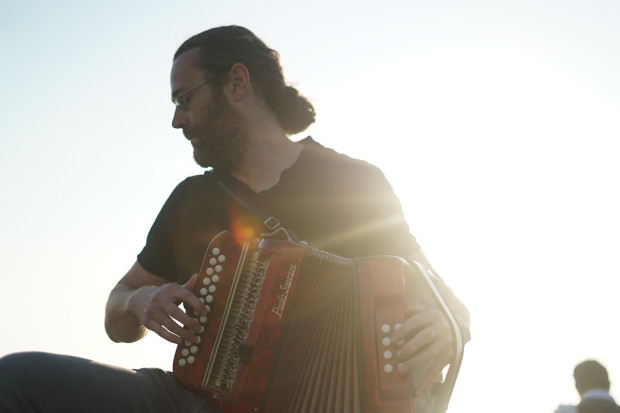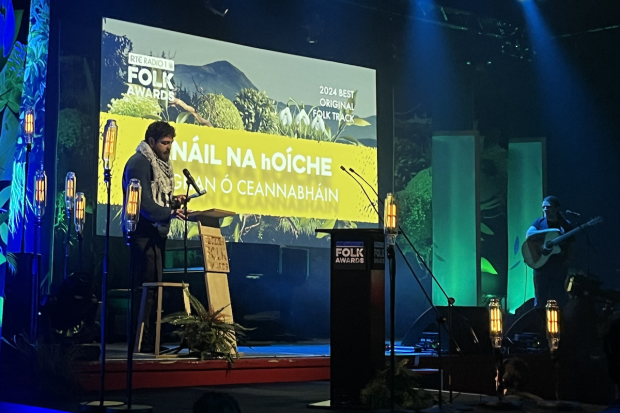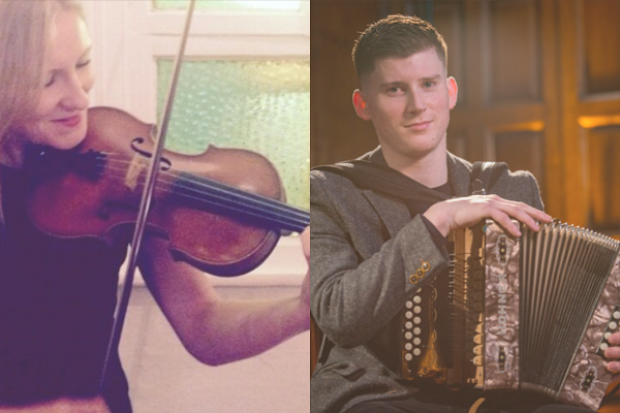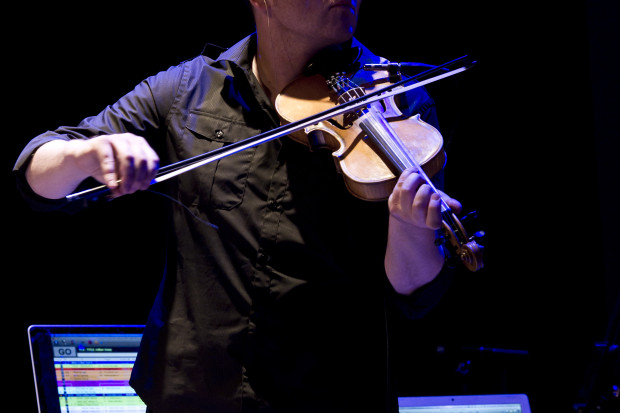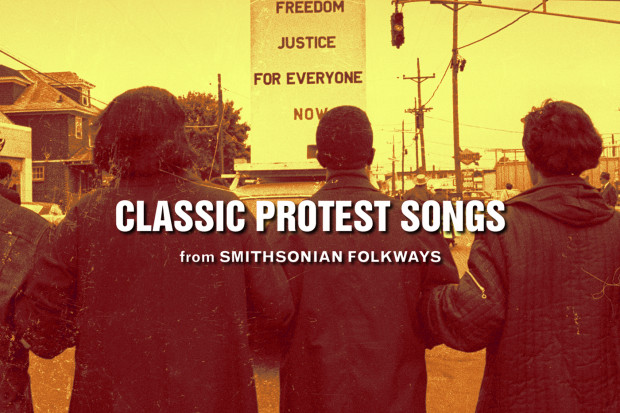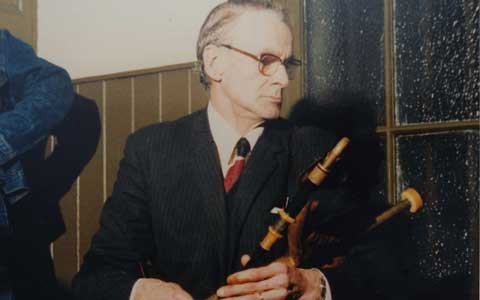
The Master
The poet Michael Davitt once remarked, having served Séamus Ennis with a cup of tea in bed one morning, that he had never seen toes as long as those of the great piper, song-collector, folklorist and singer. His fingers, however, were of a length beyond anything I have ever seen, dominated by large, protruding knuckles, reddened where the bones poked. The nail on the fourth finger of his right hand had a deep score, as if from over-cleaning and the right index finger was stained nicotine brown. He wore a gold Claddagh ring and a slim gold watch under white sleeve-cuffs.
He was the most remarkable of men. To have crossed his path as a listener was enriching; to have had him as a mentor was unforgettable. I first saw him of a summer’s day in the Scout Hill in Ennis, Co. Clare, in 1955. He sat in half profile to some forty of us, dressed in a formal grey suit, shirt and tie. Seán Reid sat next to him. Only recently has it dawned on me the great service rendered to the musicians of Clare by Mr Reid, as he was known at that time. It was he who brought the fiddle-player Tommy Potts to Ennis and his house on the Gort Road in Ennis had an open door for any musician who cared to visit. I can remember little of what Séamus Ennis played or said that afternoon, lit by a shaft of late afternoon sun. My musical education up to that point had been conditioned to gymnastics on the accordion. What I do remember is the aura of authority which he spread over our small gathering that day, looking every inch a film star.
The next time I saw him was in O’Donoghue’s bar in Dublin in 1964, dressed in a formal dark-blue pin-stripe suit which had seen better days. He had a slight stoop and when he spoke to you he exuded an air of friendly fatherhood. He was fastidious in everything he did, with a ritual for everything, whether smoking a cigarette, consulting his watch or telling a story. On one occasion, while recording in Peter Hunt’s studio on St Stephen’s Green, Dublin, Peter pressed the talk-back button and politely suggested, that due to some technical matter or other, he wished to re-record the piper’s first piece. Séamus stretched his left arm upwards at a high angle, fingers extended, looked at his watch and said, ‘That’s the way Séamus Ennis played it at 3.30 pm [on whatever date it was] – and that’s the way it’ll stay!’
He smoked Gold Leaf cigarettes and I often remarked on his ritual of opening a new packet. He would peel the cellophane wrapper off, roll it into a ball and proceed to wrap it in the silver paper covering the filters. The wrapper would go into his jacket pocket and after inhaling the first puff he would look at the glowing tip and intone a favourite comment such as ‘the game is on’, followed by a single note whistled in a low tone, the note thinning as he exhaled a melodic mixture of air and smoke.
Many are the stories he told us, and, in telling, he would often pause as if to reflect momentarily to himself on the substance of his tale. It seems to me now, trawling through the myriad of little treasures he shared with us at that time, that he always seemed to be at one with his story. When he related a fairy story, there was never even a hint of doubt or disbelief on his face. One, in particular, stands out, a story which he called ‘Don Nipper Esepto’. Based on the ‘hiring-fairs’ of long ago, it started with a small man of distinguished appearance hiring a young girl to work for him in a far-off place. They travelled a long day in his pony and trap and on reaching his little house in the woods, the man introduced himself as Don Nipper Esepto and began instructing the girl in her duties, as follows:
‘What’s that little girl,’ he said, pointing at his neat little house.
‘That’s the hut, or the teach or whatever you plase sir,’ she said.
‘No, little girl,’ he said, dropping his tone and shaking his head, ‘that’s the Great Castle of Straw Bungle.’
‘And what’s that little girl,’ he said, pointing down at his boots.
‘Them is your brógs, your boots or whatever you plase sir,’ she said.
‘No, little girl,’ he said, ‘them is my hay down-treaders.’
‘And what’s that little girl,’ he said, pointing at his little green britches.
‘Them is your trousers, your britches or whatever you plase sir,’ she said.
‘No, little girl,’ he said, ‘them is my fortunes crackers.’
‘And what’s that little girl,’ he said, pointing to his bed.
‘That’s the straw, or the comfort or whatever you plase sir,’ she said.
‘No, little girl,’ he said, ‘that’s the barnacle.’
‘And what’s that little girl,’ he said to her, pointing at the cat.
‘That’s the cat, or the cat, or whatever you plase sir,’ she said.
‘No, little girl,’ he said, ‘that’s white-faced simony.’
‘And what’s that little girl,’ he said, pointing to the fire.
‘That’s the hot, or the hate, or whatever you plase sir.’
‘No, little girl,’ he said, ‘that’s hot cockalorum.’
‘And what’s that little girl,’ he said, pointing at the stairs.
‘That’s the steps, or the stairs, or whatever you plase sir,’ she said.
‘No, little girl,’ he said, ‘that’s the wooden hill.’
Anyway, they had their dinner, they went to bed, and out in the night the little girl woke her master up and exclaimed…
(Instead of just reading here, take the deepest breath you can, and do what Séamus used to do – open your heart up and say it out loud.)
Rise up from your barnacle Don Nipper Esepto put on your fortunes crackers and your hay down-threaders and come down the wooden hill because white-faced simony has a spart of hot cockalororun on her tail and if you don’t hurry the Great Castle Straw Bungle will go up in hot cockalorum!
A year spent teaching in a bleak corner of north-western Canada led me to the most enriching month of my life, with Séamus in New York. Young and foolish, I took a year off from my teaching job in St Assam’s School in Raheny in the winter of 1963 to work for the Oblate Fathers as an unpaid volunteer teacher in the wilds of British Columbia. To my shame, there I laboured for four dollars a week plus food and board, teaching the white settlers’ ways to the oppressed Canadian Indians. The school was a religious one, situated a short distance from a wire-enclosed reservation, where Ernie Pete and my other pupils broke the winter ice to make morning coffee.
When my summer break came that June in 1964, I hitch-hiked with my accordion across Canada – from Fort St James near the north-west coast bound for New York. I reached exhaustion point near a place called Hamden in Connecticut and remembered that my Clare colleague Bobby Gardiner lived someplace in that state. The phone directory gave me his number. I feasted on greasy hamburgers and chips in his apartment and as the food kicked in, driving my blood-sugar level and my mood through the roof, I played and played my heart out, overjoyed in meeting someone from home – Bobby, a wonderful accordion player who I had first heard in Doolin many years earlier. Bobby was enthralled with the tone of my instrument, and I made a snap decision of a kind which I would go on to repeat, over and over, during the next forty years. When my mood was high, and a friend innocently admired something of mine, I’d say, ‘take it and enjoy it, it’s yours.’ That would give me an instant boost. Some would thank me and refuse, the occasional person would accept my offer. It happened with my lovely green Raleigh touring bike, with books and paintings, with my black leather overcoat, and with the family car, which I gave away during my wife’s pregnancy in 1968.
Anyhow, Bobby was in O’Donoghue’s bar the following summer and I gave the accordion to him. I have always regretted that bit of foolishness. I had bought it for £16 from Tommy Moore’s shop on Harcourt Street, and had a cup of coffee afterwards at The Green Toureen, a small restaurant which was soon to feature the first folk music club in Dublin.
On arrival in New York two days later, I heard that Séamus Ennis had come to play at the Newport Folk Festival. I found him sitting in a posh pub called the Limelight in Greenwich Village. I had neither money nor accommodation so he invited me to stay in the flat he had borrowed from an actor by the name of Theo Bikel. I became his assistant; I carried his pipes, did the shopping and encouraged him to eat, which was not easy. Séamus was quite a celebrity in Greenwich Village. We spent our evenings at the Limelight where he held court at the bar counter. It was the height of summer, the pub was air-conditioned and he wore a grey tweed suit, white shirt and loosely knotted tie. He smoked and steadily drank orange juice laced with vodka, singing and telling stories but playing very little, apart from an odd tune on the tin whistle. He encouraged me to play, and would give me a critical analysis of some reel that had taken his fancy.
I sat at his feet and he instructed me in the playing of ‘Sliabh na mBan’, ‘Bean Dubh an Ghleanna’ and ‘The Wounded Huzzar’. He was a strict master, quick to ask why you had added a particular note of embellishment where none was needed. In the playing of slow airs, he insisted on my learning the words of the song, and would get me to repeat each line after him, telling me which note he wanted me to emphasise by what he called ‘the shiver’, a gentle tremor of the accordion-bellows:
Tá bó agam ar an sliabh
Is tá mé seal in a dhiaigh
Nó gur chailleas-se mo chiall le nuachair…
A seoladh soir is siar
I ngach áit a dteann an ghriain
Nó go bhfilleann sí chugham trathnóna…
(I have a cow on the mountain
And I have been following it for some time
Since I lost my senses with my love.
Leading it to and fro
Everywhere the sun goes
Until she returns to me one day.)
One sultry afternoon, a willowy young lady from California knocked at the door and asked Séamus if she could interview him for a folk-music magazine. Her name was Rita and she produced a Uher tape-recorder, a machine of impressive steely authority, compared to the plastic Grundigs we had at home. We went to meet the distinguished folklorist Ralph Rinzler that night and we had dinner in a palatial apartment owned by the same Theo Bikel. A Vortexion reel-to-reel tape-recorder sat on a shelf in the centre of one wall and Séamus played, talked and sang until the small hours of the next morning.
Back in Dublin that autumn of 1964, we shared a flat at 3 Home Farm Road in Drumcondra. It was a happy and a memorable three months. While working on a poetry and traditional music show called The Frost is all Over in 2008, I asked the poet and novelist Dermot Bolger of Finglas to write a poem about Séamus, based on memories of life in that flat, as I had recounted them to him. Here is what he produced:
I see him leave that flat we shared
And walk down Home Farm Road,
Black coat buttoned against the wind,
A countryman’s hat pulled down,
And in his hands a battered case,
Containing the set of uilleann pipes
Found in fragments by his father
In a sack in a London pawn-shop:
A jigsaw nobody could piece together
A hundred years after they were crafted
By Coyne of Thomas Street in Dublin.
He carried his case like a secret dossier
That no passer-by could decode
As he boards a bus into the city
Unnoticed among the evening hordes.
Times are hard, our flat threadbare,
He survives on tins of steak and kidney pie,
On meals that he cooks at odd hours,
When he tells yarns and truly comes alive.
There is rent to pay, a meter to be fed,
Afternoon visits to the local laundrette
Nights of wind rattling the rotten windows,
When he spreads his coat over the bed.
This is the price of making music,
Of living the life for which he was born,
He is on his way that night to perform
For little pay to a meagre audience
In the back room of a Dublin pub,
With a television blaring in the lounge.
Ignoring the jarring cash-register,
Three dozen sit, transfixed,
By a set of reels learned from his father
Interlaced with grace-notes and tricks
Picked up from pipers who are ghosts,
Who died recorded only by himself,
Who never learnt music, wrote nothing down,
But carried the tunes in their minds.
Knowing that with their own deaths
Dozens of nameless tunes would also die.
Ennis plays with due respect for the dead,
In his one good suit, a white shirt and tie.
I adored the ground Séamus walked on, and I broke a commitment to him for which I have never forgiven myself. We both had some engagement or other in my home town of Ennis in the late 1970s and I offered him a bed in my house on the Turnpike Road. My mother was alive at the time, but I forgot to tell her about Séamus, went to bed and sometime after midnight he called out my name from the street below. ‘Who is that?’ my mother asked me, standing by my bed, and when I told her it was my friend Séamus Ennis she stated firmly, ‘He’s not coming into this house.’
Her resolve hit me like a brick; usually quiet and mournful, she stood by my bedside, exuding an uncharacteristic aura of steely authority. I was in her house. I was in my thirties, she in her sixties, and every effort I made to get up and bring Séamus in, she stopped me with an iron will.
It was shocking to be forced to keep quiet and to stay lying down by a force I had never before experienced, and until recently I had never even begun to understand. But then I trawled the Census of 1911. My mother was born in 1902. Her mother died giving birth, and her father was born in 1847 during the Great Famine. It was then that it hit me like a brick – she had often talked about her father seeing dead bodies in a field, their mouths stained with the wild green of grass. She grew up without a mother, married in 1919 at the age of seventeen, lost her first infant and was confined to bed with sickness and despair for two years. It was a friar who finally prayed over her and got her out of bed. I remember how she had so often talked about the scourge of tuberculosis, which in my youth was ebbing but still paralysing the mothers of Ireland with dread. When it entered a house, misery reigned, and stayed.
I had previously told her of the day Séamus Ennis came out of the TB hospital in London to find his belongings packed and waiting outside the front door of his home….
Ancestral memory dies hard.
I still remember the cadence of his voice as he called my name from the pavement under my bedroom window that night; over and over he called, his voice falling and softly faltering as I lay transfixed in my ground-sweat. It was at the launch of the book Going to the Well for Water: The Séamus Ennis Field Diary 1942–1946 last December that a verse from one of the songs he had collected from a singer in Conamara came back to me:
Tá mé bruite dóite sciúrtha feannta
Liobraithe gearrtha le neart den tsiúil
‘gus a mhister Joyce tá an workhouse lán
is ní ghlacfar ann isteach níos mó.
(I am tired, lashed, frozen, upset
And lacerated from all the walking
And Mister Joyce, the workhouse is full
And they won’t accept anyone else inside.)
Published on 1 February 2010
Tony MacMahon (1939–2021) was a traditional musician and television producer in RTÉ, where he produced The Pure Drop, The Green Linnet, Aisling Gheal, The Long Note, The Blackbird and the Bell and many other series. He made three solo recordings, Tony MacMahon (1972), MacMahon from Clare (2000), and Farewell to Music (2016) and recorded I gCnoc na Graí (1985) with Noel Hill and Aislingí Ceoil (1994) with Noel Hill and Iarla Ó Lionáird. Read our full obituary here: https://journalofmusic.com/news/rip-tony-macmahon










